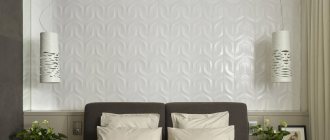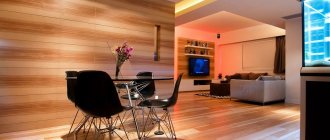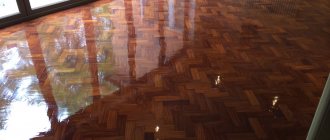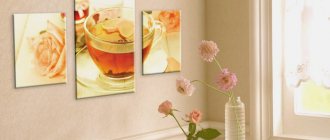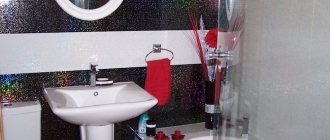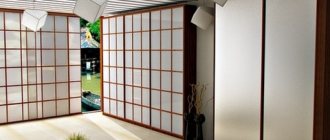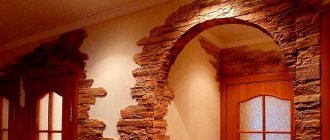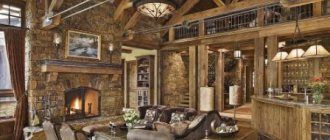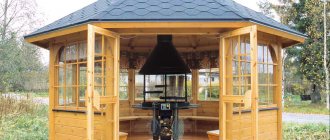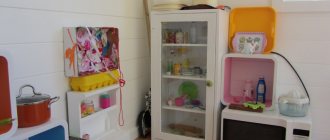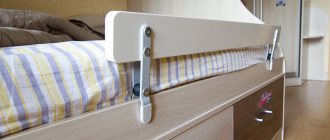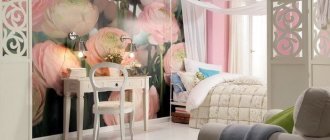Today, parquet made of natural wood is deservedly considered the most popular floor covering, embodying sophistication and beauty. The price of such a finishing material is not affordable for everyone, but it is fully justified by the reliability, practicality and attractive appearance of parquet.
In order for the decoration to transform and decorate the interior, it is necessary to choose the right color. The harmony of all elements in the room will create a comfortable atmosphere, and the interior style will be revealed in all its glory. Later in the article we will take a closer look at this type of flooring and talk about how to choose the right color for the product.
Wall decoration with parquet boards: design options in the apartment
There are several design options when decorating walls with parquet boards:
- Across the wall;
- Along;
- In a diagonal direction;
- Over the entire surface of the wall;
- On a separate site;
- Arbitrarily.
Depending on the style of the room, the choice of parquet design may vary, which will merge into a single image with the rest of the room or emphasize its individual parts.
Sheathing on plasterboard walls
In the case where the walls were lined with plasterboard as part of a previous or current renovation, this only plays into the hands and also makes the work of the home craftsman easier. You will need to make a sheathing of wooden slats 20x20 mm, with a distance between the slats of thirty to forty centimeters.
The sheathing under the sheets must be installed level, and therefore it is recommended to use a building level.
The orientation of the parquet and sheathing slats is directed in different directions, that is, they must be perpendicular to each other. If the tiles are placed diagonally, the slats will go in the same direction, but they must be perpendicular to the floorboards.
If only the lower section of the wall is sheathed, then work also begins from below. But if the entire wall is to be sheathed, then the first tile is laid in the upper part. Then the movement is from left to right. In this situation, the same rules for laying parquet as on the floor apply - there is a need to provide a technological gap between the walls and the edge of the parquet.
The dies are attached using parquet glue or by driving staples into the corresponding locking joints. If glue is used, it is applied not only to the wall, but also to the back of the dies, using zigzag movements.
As the final stage, the installation of skirting boards and corners is carried out. Thanks to them, technical gaps left in advance are closed, as well as joints with the floor and ceiling.
How to mount on concrete or brick walls
The process of installing concrete or brick walls will be no different from a wall made of plasterboard or chipboard. The main requirement is that the wall must be smooth and free from flaws, defects, and damage.
If it is necessary to mount heavy objects on the wall, a concrete wall partially wins among other options. The most powerful fasteners can be driven into a concrete wall that can withstand heavy loads. For other situations, you will need an individual approach when choosing the type of fasteners and the method of their location.
How to use?
A bedroom design with laminate will look organic if you do not overdo it with the amount of material. The most common place for finishing is the wall behind the head of the bed.
Important! You need to select the color of the laminate for the walls in accordance with the color of the furniture - this will create the integrity of the interior.
It is advisable not to overload a wall decorated with laminate with decor, since this element itself is visually powerful. Although the material can easily withstand shelves and other hanging elements.
Laminate flooring is easy to maintain both on the floor and on the wall
Beautiful glossy laminate on the bedroom wall looks good in a modern interior
Stylish modern bedroom with laminate on the wall and floor
Laminate on the walls should match the overall color of the furniture in the bedroom
Examples in the kitchen and living room
With the right selection of materials for wall decoration, you can achieve significant design success. The result also depends on the choice of textiles, furniture, colors and some other factors that are taken into account when decorating a kitchen or living room.
In these rooms, variations in the laying of parquet are of considerable importance. Depending on the expected effect, you can use one of the main options:
- The horizontal arrangement of the panels makes it possible to visually expand the room, which can be important for a kitchen, which is usually small.
- Vertical installation visually increases the height of the ceilings. This trick is best applied to the living room to achieve incredible design solutions.
- Diagonal cladding is a universal option that makes it possible to blur the volume and boundaries of the room.
Coating features
The first and main feature of parquet is its naturalness, which creates aesthetic charm. Wood, regardless of color and texture, looks impressive, stylish and sophisticated.
Natural materials have always attracted attention due to their special beauty, which artificial coatings cannot fully recreate.
The size and shape of the boards can be varied. On the basis of residential premises, as a rule, rectangular or triangular dies are used. They are convenient to install in rooms with standard dimensions.
As for the size of the boards, it is selected based on the size of the room. The larger the area, the larger the dies are used and vice versa.
A wide range of products of various shapes and sizes are available for sale.
Care
When the coating receives minor damage during installation or operation, they can be repaired using putty or special wax.
Parquet panels are cared for using specialized care products. Follow the correct humidity and temperature ranges as specified by the manufacturer.
Using parquet as a wall covering is an unusual, but original and practical solution. This is an easy-to-install and maintain material that is suitable for a wide range of users.
Color selection
To withstand heavy loads, it is better to choose hard wood, which also has a long service life and is more resistant to moisture and temperature changes. Based on the color of parquet in the interior there are:
| Dark (wenge and stained oak) | Massive furniture in a classic-style interior, white walls and furniture, red finishing tones and beige textiles go well with a dark floor. |
| Red (kempast, paduk, doussia) | Rarely used due to the fact that such trees grow in Africa and Asia. |
- Pink is common and has low density (beech, pear, alder).
- Yellow is in great demand in different latitudes (teak, olive, iroko).
- Brown has a high density, wood is widely represented throughout the world (walnut, kumara, rosewood, merbau, scupira).
The photo in the bedroom interior shows a modular light parquet floor coated with varnish. This coating emphasizes aristocracy even without stucco on the ceiling.
White parquet
Gray parquet
Black parquet in the interior
Useful video
Recently, when it comes to renovating an apartment or house, people are increasingly turning to a style of room decoration such as retro or antique finishing.
This style includes a method such as antique plaster or, as it is also called, antique wall painting.
If you want the reflections of ancient times to sparkle in your home, so that the room is made in the spirit of the good old classics, then this finishing option is the most suitable for you. It will help give the room that same effect of antiquity and classic design.
The word “plaster” itself is usually associated with a certain building mass of lime mortar to which sand has been added. It is used for surface leveling and rough finishing. However, this understanding reveals only one side of this concept. Please note that if you add dye and some auxiliary substances to this building mass, you can get an interesting material for creating unique images, in particular antique walls.
Antique decorative plaster became so called due to the resulting appearance, slightly rough and shabby. This is achieved thanks to the latex included in its composition and a special technique for applying the solution to the walls. The result is a light tint effect in areas of greatest friction.
Antique mixtures are durable and easy to maintain.
The positive aspects of plaster with an antique effect include:
- high strength;
- Possibility of use for interior and exterior work;
- Possibility of use in rooms with high air humidity;
- environmental friendliness of the material;
- fire resistance;
- ease of care.
Application technology
As when working with conventional plaster, before finishing walls in an antique style, it is necessary to perform preliminary surface preparation. It is imperative to level the walls, remove all defects, dents, crevices and cracks.
After this, use a construction vacuum cleaner to remove dirt and dust. It is recommended to use a special vacuum cleaner, since construction dust can cause damage to the household appliance due to its entry into the motor through the filter.
Be sure to prime the walls
Now the dry and clean wall must be primed to improve the adhesion properties of the material to the surface. Typically the primer is applied using a long-nap roller or a wide brush. It is convenient to use a spray bottle to spray liquid for this purpose.
After applying the primer, you must wait until the wall is completely dry before you can begin applying the plaster. As a tool, you can use a brush or a long-haired roller.
The plaster is applied in a circular motion, while in some places you need to apply more pressure so that the effect of antique wear appears. If necessary, you can repeat the layer using a slightly different shade from the first. After this, be sure to let the surface dry. Drying usually takes 8-12 hours.
At the final stage, the wall must be rubbed with a hard sponge or fine sandpaper using a special grater. To give the surface a smooth look and shine, you can cover the walls with shiny wax.
The crackle effect is achieved by applying several layers of paint and varnish
Plastering antique walls is the most common way to decorate walls, but it is not the only one. There are cases when craftsmen and designers line the walls with wooden paneling. How to achieve the effect of an antique interior here?
Antique processing of wooden walls allows you to create an internal classic atmosphere, with which you can plunge into the times of our grandparents and great-grandfathers.
Carrying out the work of aging a wooden element is not as difficult as it might seem at first glance.
To give wood an antique effect, you will need the following tools and materials:
- axe;
- metal brush;
- hair brush;
- brush;
- sandpaper;
- drill;
- stain, acrylic paint, wax and clear varnish.
With these tools you can achieve the desired result very quickly and you don’t have to wait for the wood to age naturally. The aging effect is achieved by simulating abrasions, cracks and artificial depressions.
Wood aging technology
With the help of an ax, small potholes are made in the wood.
With the help of an ax, potholes of different sizes should be made on the surface of the lining in any order along the entire wall. In some places we cut off the corners, not paying attention to the accuracy of the work.
After this, the finished areas must be thoroughly sanded using a wire brush. Since the volume of the walls is considerable, a lot of effort is required, you can resort to using a drill with special attachments. Watch a master class on aging wood in this video:
An example of an aged wooden board
During grinding, it is necessary to smooth out all sharp nicks obtained with an ax until the effect of natural damage to the wood occurs. Movements must be performed along the wood fibers. Next, using sandpaper, we remove all protruding chips, while small depressions may form, which will also give our walls the effect of natural aging.
Cover the wood with a dark stain
At the next stage of working with antique wood, you should give the light surface a resemblance to a board that has darkened over time. To do this, we treat the lining using a special stain or dark acrylic paint. After waiting for it to dry completely, sand the surface again with medium-hard sandpaper. You don't have to put in any special effort.
At the final stage, the walls should be waxed or coated with clear varnish and the surface should be allowed to dry.
Antique wall decoration can be done in different ways. We looked at such a common option as antique plaster, and a less common option - antique wooden wall finishing. For an example of antique wall decoration, see this video:
Whatever method you choose, retro style will help transform your home and give it an incredible classic design. The work of giving the walls an antique look is not so difficult; even a non-professional can handle it. All that remains is to add elements of classic-style furniture, and the result will pleasantly surprise you.
Today, various materials are used to decorate a room, and boards for decorating walls in an apartment are recognized as the most popular material.
This is due to the environmental friendliness of the material, its practicality and durability. Later in the article we will tell you which decorative boards for wall decoration can be used to create the interior of an apartment or house, and also provide some simple recommendations for attaching the material.
Bottom line
Parquet is a beautiful and noble covering. It is unique in its variety of colors, textures, and performance qualities. Natural wood flooring is valued for its environmental friendliness and ability to add warmth and comfort to a home. So when choosing flooring, think about how it will form the basis of the design of the entire room.
Warm and beautiful flooring - parquet, popular in the first half of the 20th century in the USSR, has again attracted attention. And if you want to decorate your home (and not just the floor) with such a coating, it’s worth understanding what types of parquet there are and how they can be used in the interior.
Advantages and disadvantages of finishing boards
Boards for interior wall decoration made from natural material (or based on it) have a number of positive qualities, for example:
- Such interior decorative material for the home as wood can be used in different climatic conditions.
- This opens up the opportunity to create any structural element with your own hands.
- Wooden beams are a natural and environmentally friendly material.
- This type of wall covering does not cause any difficulties during operation.
- This finishing material has a long service life.
- In case of failure of a separate fragment, a partial replacement can be performed.
- Laying technology allows you to additionally insulate or insulate the walls of the building.
- The ability to create a different style, age the canvas or choose the desired texture and shade.
- Affordable price.
Despite many advantages, facing surfaces with unedged or edged boards also has some disadvantages, namely:
- Due to an increase in the level of humidity in the room or from exposure to moisture, lumber loses its physical qualities.
- Boards without additional treatment with protective agents support combustion.
- This building material has various defects inherent in wood (resin pockets, knots, cracks, etc.).
- At some intervals, the boards require painting or other maintenance.
- Without treatment with antiseptic solutions, fungi and mold can develop on wood.
Types of parquet
There are four main types of parquet. Each of them has its own advantages and disadvantages: Planks of different shapes and sizes with grooves for fastening and ridges. Among its advantages: rich design variety, easy replacement of strips (if necessary). Disadvantages include: high cost, instability to moisture, the need for additional processing (varnishing, grinding).
It consists of three layers, two base layers are made of coniferous wood, the third top layer is made of valuable wood. Parquet boards are cheaper than piece parquet. It is ready for installation and does not require processing. It is not resistant to moisture and can become deformed from large amounts of moisture. Another drawback is the poor choice of colors.
Solid wood covering. It is much thicker than parquet boards and cheaper than piece parquet. It's easy to install and care for. The solid board is not glued, so it is environmentally friendly and has a rich color palette.
A coating that is resistant to temperature changes and moisture, which is most often used on open terraces or in saunas.
Types of materials
Today, the most popular materials made from wood or based on it are:
- Lining.
- Boards imitated as timber.
- Block house.
- Siding.
- Not an edged board.
Let's look at each of the materials in more detail.
- Lining. As a rule, solid wood is used for production, so the material has a high level of strength and does not cause difficulties during installation. A distinctive feature is that such finishing can be replaced in case of damage, as well as painted, varnished, etc. Since the lining can be presented in different variations, including physical characteristics, it is equally well suited for interior decoration premises, as well as external work (finishing a bathhouse or sauna, terrace, kitchen, and even a living room or bedroom), this can be seen just by looking at the photo.
- Imitation of timber. This is a material that, when assembled, is similar to solid timber. It is this distinctive feature that allows you to give the room solidity. Such a massive and durable material has a high level of strength, is not afraid of mechanical stress, and is also able to withstand environmental factors, but only after specialized processing.
Advice! As you can see, this finishing option is especially good for the living room, and is especially often used in country houses. Installation of the blade is very simple, thanks to the presence of “locks”: the tenon fits into the groove, which significantly speeds up and facilitates the work. This allows you to use the material not only as floor or wall decor, but also to fix it on the ceiling without much difficulty. Ceiling beams will help harmoniously complement the picture and give the room a special atmosphere.
- Block house. This material allows you to imitate a log house made from a cylindrical log. It is used inside and outside buildings due to the presence of canvases of different thicknesses and widths. As a rule, coniferous wood is used to make such boards, which gives not only realism, but also a natural appearance. Larch, cedar or aspen can also be used.
- Planken. This is a small decorative board that is used to decorate small areas inside and outside the house. The material has different textures and comes in a wide range of colors, and easily tolerates moisture. The material is laid end-to-end, but with a small gap, because the material can expand from exposure to moisture.
- Siding. Siding is a decorative material, for the manufacture of which both synthetic and natural materials can be used. Finishing with such material allows you not only to imitate a wooden surface, but also to choose the optimal color and texture. Siding panels are very durable, are not afraid of the sun and moisture, which is why they are often used for exterior decoration. The panels are installed on the sheathing using brackets. Also, when purchasing material, the kit includes instructions and elements that allow you to hide seams and cuts.
- Not an edged board. The material is a board that has a raw edge. This finishing material allows you to create an original room design, especially if you correctly complement it with decorative elements.
How to age wood (video)
Increasingly, walls are decorated with unedged boards without first clearing the wood of bark, which allows you to create the effect of antiquity (a detailed video lesson on how to age boards can be seen below):
Finishing a wall in a bedroom with unedged boards, as in any other residential or non-residential premises, requires pre-treatment of the wood with protective agents that will protect it from moisture and sunlight. I would also like to note that decorating walls with parquet boards, as well as decorating walls with planed boards in a herringbone pattern, are no less popular.
What is laminate?
Laminate is considered a floor covering that has proven itself to be excellent. The material consists of 4 layers:
- The base, which can be wood chips or solid wood.
- Pressed paper treated with a special compound that makes it waterproof.
- The decorative layer is also paper, but it has a characteristic embossing and color applied to it. This is the main layer that determines the appearance of the material.
- The protective layer is exactly what lamination is. It is transparent and reliably protects the decorative layer from damage.
Laminate at the head of the bed serves as an original decoration for the bedroom
Eco-style bedroom with beautiful brown laminate on the wall
Laminate on one of the bedroom walls in addition to laminate on the floor
Note! Even the smallest class 21 laminate can be installed on the wall in the bedroom, since there will be no strong mechanical or temperature influences in this room.
Laminate on the wall is not yet particularly popular in our country
White laminate on one wall looks good with light brown laminate on the bedroom floor
Approximate cost of material
The table below shows the approximate cost of wood from which planed finishing material can be produced.
| Hardwood: | Cost per m2: | Coniferous wood: | Cost per m2: |
| Linden: | From 700 rub. | Larch | From 750 rub. |
| Alder: | From 900 rub. | Cedar | From 550 rub. |
| Oak: | From 3000 rub. | Pine or spruce | From 350 rub. |
| Ash: | From 1500 rub. | ||
| Aspen: | From 1200 rub. |
Since decorating the walls in the kitchen with boards has some differences from installing boards in the bathroom or bedroom, below we will try to highlight the most relevant tips and tricks that we hope will make your work easier.
- The boards can be fixed to a frame partition or glued directly to the walls, like wallpaper, with liquid nails (the wall must be perfectly flat).
- Try not to use an old design solution by choosing one color of wood, even if the species is expensive. Today it is very fashionable and popular to combine different colors and textures, brush boards and even give the walls additional volume by fixing the canvas with an overlap or a herringbone pattern. Thus, finishing the walls with boards in the Provence style looks great.
- The combination of horizontal, vertical and diagonal fixation of boards looks no less original. You can also insert parquet or brushed material or laminate into this combination, creating a herringbone pattern.
- To finish paintwork materials, try not to use synthetic materials, or better yet, do not use them at all.
- If you still decide to use a plain material, decorative elements, additional lighting, and fresh flowers will help to dilute it.
- Since old pallets (pallets) have recently been very often used for finishing in order to save money, it is not recommended to use them in children's rooms. To arrange children's rooms, instead of Euro pallets, it is best to take parquet or other hollow, smooth material that your baby cannot get hurt on.
There is an opinion that the ever-expanding range of finishing materials should gradually displace and eliminate outdated options, but in reality this is not what happens. Traditional solutions are modified under the influence of modern requirements and appear before customers in a completely different light. The most significant example is wood. Well, it would seem that the material is familiar, but over time it not only did not lose, but also strengthened its position.
Today, interior decoration using wood is considered an extremely stylish design option, since wood is not only an aesthetic, but also an environmentally friendly material. Some people mistakenly believe that the only available option is clapboard wall decoration. In fact, there are a large number of alternative paths, which will be discussed below.
Today, the construction market offers a large number of different types of boards: facade, deck, . The last option is the most popular. The demand is due to several reasons.
Material advantages
- It is quite simple to manufacture, since a variety of different types of wood are used for production: from ash, maple, beech, larch to cherry, cherry and pear.
- A wide range of shades allows you to choose the right option for each interior. You can purchase wood in a light shade, or you can find material in a deep dark color.
- Each of the mentioned types of wood belongs to high-quality species and has excellent performance characteristics.
- Parquet boards as a finishing material for walls look good in the interior.
- The affordability of parquet boards allows you to decorate a large room without significant financial costs.
- Additionally, you can “decorate” wood using special stains and wax impregnations. They will not only extend the service life of the material, but also change the appearance for the better.
Prices for different types of parquet boards
Parquet board
Proper covering of the surface with solid wood boards allows you to get a spectacular interior that will be the envy of all your friends. The use of special impregnations based on wax and oils gives the boards a velvet-like appearance. In addition, these products allow you to create a film on the surface of the boards that repels water, which prevents the development of fungus and mold.
Some apartment owners strive to make their homes original and even extravagant in some ways. So if you are tired of boring solutions, then pay attention to the block house, that is, a board whose cross-section imitates the rounded log known to everyone from village landscapes. With the help of this material you can achieve a real “rural” interior in your home.
To make the design look even more impressive, it is recommended to resort to a method such as artificial “aging” of the wood. For this, the method most often used is “brushing”, that is, processing the material with a wire brush. During the processing of wood, fibers are removed from it, which creates an interesting relief. After this, the material is painted and, without allowing the paint to dry, it is removed.
Tools:
- a simple pencil;
- ruler;
- silicone;
- screwdriver;
- screws;
- glue;
- block for tamping laminate;
- jigsaw;
- hammer;
- moldings;
- thresholds.
Laminate with glue
This method seems to be the simplest and does not require additional skills. To make your task easier, it is recommended to assemble the shields from purchased panels in advance. You should thickly coat the “sides” of the panels with glue and glue the elements together so that you get full-fledged shields. These are the ones we have to fix on the surface of the wall. It is important that it is prepared in advance. It will not be superfluous to carry out markings.
The only thing to remember for a successful result: work should start from the lower left corner. In this case, it is recommended to remove the platbands, which are then installed in the old place.
Laminate on sheathing
Stage 1. We take the necessary measurements, calculate the amount of laminate, as well as the number of moldings and other parts that will be needed for fastening.
Stage 2. Using a ruler and pencil, apply markings to the surface of the wall.
Stage 3. Remove platbands from doors and windows.
Stage 4. We install the sheathing, that is, the frame. This is done quite simply - take wooden blocks and fasten them perpendicular to the floor, but parallel to each other at a distance of 40 cm.
Stage 5. We begin to install the material, as already indicated above, from the lower corner of the left side of the room.
Stage 6. We cut the wood in the corners using a hacksaw or an electric jigsaw. Stage 7. We arrange the planks in a checkerboard pattern.
Stage 8. Treat the joints with silicone.
Stage 9. Latch the locks.
The technology of laying it on the wall is really very simple and will not cause any difficulties.
Prices for different types of laminate
Wood wallpaper is an alternative to real wood finishes. A paper base is used as a base, and a special wood veneer is applied to it. The material is sold in rolls.
The cost depends on many factors, but the main criterion is the price of raw materials.
The process of applying wooden wallpaper to the wall surface is not much different from the technology of applying conventional wallpaper. The only difference is the result, as we end up with a wall that looks like it was made of wood.
One of the most unusual and popular interior design options today is saw-cut finishing. A transverse section of a trunk of small thickness is used as the main decorative element. This finishing method is so popular that by now manufacturers have already begun to produce wallpaper and tiles that imitate this pattern. Decorating the log walls in a room is very simple.
First of all, you need to decide how much area you want to occupy with cross sections. Experts do not recommend overdoing it, since an unusual type of decoration on a large scale can only spoil the interior. The best option is one wall, preferably the one located at the head of the bed.
It is necessary to paint it in a calm color, and then apply logs using special high-quality glue. They can be attached close to each other or you can come up with an interesting fragmentary pattern. It all depends on the imagination of the performer.
The most popular type of wall surface finishing using panels is considered to be a herringbone pattern. To implement it, you will need tools such as a protractor, a hacksaw, adhesive tape (double-sided), casing and a pencil.
The finishing process consists of several key stages:
- calculation;
- marking;
- cutting planks;
- fastening.
Let's look at each of them in more detail.
Step 1. Draw up a diagram on a piece of paper of what the finished wall should look like. It is very important to pay attention to the accuracy of measurements. This is an extremely important stage, so you should not approach it carelessly.
Step 2. Using a simple pencil, draw a straight vertical line clearly in the middle of the wall. It will serve as a boundary for the correct laying of the panels.
Step 3. Prepare the panels. This means we take them and cut them at a 90 degree angle so that one edge is slanted. One half of the boards should be cut from the right corner, the other from the left.
Step 4. Take double-sided adhesive tape and attach it to the panels. It is important that each strip has three longitudinal strips of tape.
Step 5. First of all, we attach the middle elements. For this you will need an assistant. We apply the planks at oblique angles, focusing on the drawn line. It is important to ensure that there are no gaps between them.
Step 6. Fix the panels on the wall. To do this, remove the protective film from the elements and press the planks tightly to the surface.
Step 7
This option is most often used for bedrooms, but you can try it in the kitchen as an experiment. Don't be afraid to trust your taste and realize your fantasies. In addition, wood is a material that makes it easy to realize creative ideas.
Prices for popular finishing wall panels
Wall panels
Video - DIY tree on the wall
Golden mean?
Parquet boards are a reasonable compromise between laminate and parquet flooring. It appeared in Sweden 60 years ago. What is the difference between the material and its analogues? Parquet board is a natural covering of wood, it is produced, however, according to the principles of pie, however, unlike laminate, it uses 100% natural ingredients. The stabilizing layer consists of pine and spruce plywood, and the middle layer consists of wood strips of common species. The top layer is the most valuable; it represents a cut of oak or walnut wood. The fibers of the layers overlap.
How the parquet board will look on the floor depends on the owner and designer. Choose the classics: herringbone, deck laying, wicker. Combine material with insert. It is fashionable to cover the floor with artificially aged parquet boards.
The fact that parquet flooring is the main decoration of the house
, probably everyone knows. Nowadays, those who want to decorate their home with parquet have a huge selection of various types, colors and shades. Usually, when choosing one or another type of parquet, the consumer tries to link the style of future parquet floors with the overall design of the house or apartment. In addition, the interior decoration of individual rooms requires careful selection of parquet wood according to color and tone.
Oak parquet floors are versatile. Well-installed oak flooring can brighten up almost any room. Maple wood, with its light, slightly pinkish tint, gives softness and warmth. Floors made from exotic woods look very impressive: cherry, walnut, acacia or mahogany. In some cases, parquet flooring, for example, artistic, can serve as a dominant feature in the interior design of a room.
There are several types and varieties of parquet.
Let's briefly talk about some of them:
For some reason, custom parquet floors are called palace floors
, or even
highly artistic
, referring to the fact that the outlines of individual parts of such parquet have a mainly curved shape, although, you see, this difference concerns more the features of the method of production of such parquet than its artistic perception on the floor.
In conclusion, it should be noted that all types of artistic parquet, as well as custom parquet, use natural wood that has a natural color. Some foreign manufacturers use deep dyeing to produce piece parquet. The planks of such parquet have a noticeable color saturation and look somewhat unnatural, although beautiful. During the use of floors made from such parquet, a significant change in its color is possible, therefore, in order not to be disappointed with your beautiful parquet floor in the future, always use only natural, unpainted materials.
Since its invention in Europe in the 13th century, parquet has been considered the most luxurious, noble, sophisticated and incredibly beautiful floor covering, subtly emphasizing the style and exclusivity of the room. Parquet is always at the peak of popularity.
Firstly, it has proven itself perfectly from a practical point of view: it is natural, durable, repairable, and with proper care will last for many decades. Secondly, thanks to its impeccable aesthetics and “multi-facetedness”, beautiful parquet is suitable for any design style; it defines and sets the tone for the design. Let's figure out what role parquet plays in the interior, how the color of parquet affects the geometry and appearance of the space, when it is better to give preference to light or dark tones, and in which cases it is better to limit ourselves to neutral shades.
